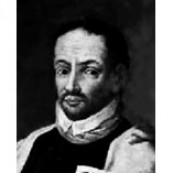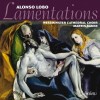Composers
Alonso Lobo (February 25, 1555 (baptised) – April 5, 1617) was a Spanish composer of the late Renaissance. Although not as famous as Tomás Luis de Victoria, he was highly regarded at the time, and Victoria himself considered him to be his equal.
Lobo was born in Osuna, and after being a choirboy at the cathedral in Seville, he received a degree at the University of Osuna, and took a position as a canon at a church in Osuna sometime before 1591. In that year, the Seville Cathedral appointed him as assistant to Francisco Guerrero, and he later became maestro de capilla during Guerrero's leave of absence. In 1593, Toledo Cathedral hired him as maestro de capilla; he remained there until 1604, when he returned to Seville, where he died.
Lobo's music combines the smooth contrapuntal technique of Palestrina with the sombre intensity of Victoria. Some of his music also uses polychoral techniques, which were common in Italy around 1600, though Lobo never used more than two choirs (contemporary choral music of the Venetian school often used many more — the Gabrielis often wrote for as many choirs as there were choir-lofts at St Mark's Basilica). Lobo was influential far beyond the borders of his native Spain: in Portugal, and as far away as Mexico, for the next hundred years or more he was considered to be one of the finest Spanish composers.
His works include masses and motets, three Passion settings, Lamentations, psalms and hymns, as well as a Miserere for 12 voices (which has since become lost). His best-known work, Versa est in luctum was written on the death of Philip II. No secular or instrumental music by Lobo is known to survive today.
Recently Added
| Country: | Spain |
| Period: | Renaissance |
Biography
Alonso Lobo (February 25, 1555 (baptised) – April 5, 1617) was a Spanish composer of the late Renaissance. Although not as famous as Tomás Luis de Victoria, he was highly regarded at the time, and Victoria himself considered him to be his equal.
Lobo was born in Osuna, and after being a choirboy at the cathedral in Seville, he received a degree at the University of Osuna, and took a position as a canon at a church in Osuna sometime before 1591. In that year, the Seville Cathedral appointed him as assistant to Francisco Guerrero, and he later became maestro de capilla during Guerrero's leave of absence. In 1593, Toledo Cathedral hired him as maestro de capilla; he remained there until 1604, when he returned to Seville, where he died.
Lobo's music combines the smooth contrapuntal technique of Palestrina with the sombre intensity of Victoria. Some of his music also uses polychoral techniques, which were common in Italy around 1600, though Lobo never used more than two choirs (contemporary choral music of the Venetian school often used many more — the Gabrielis often wrote for as many choirs as there were choir-lofts at St Mark's Basilica). Lobo was influential far beyond the borders of his native Spain: in Portugal, and as far away as Mexico, for the next hundred years or more he was considered to be one of the finest Spanish composers.
His works include masses and motets, three Passion settings, Lamentations, psalms and hymns, as well as a Miserere for 12 voices (which has since become lost). His best-known work, Versa est in luctum was written on the death of Philip II. No secular or instrumental music by Lobo is known to survive today.




